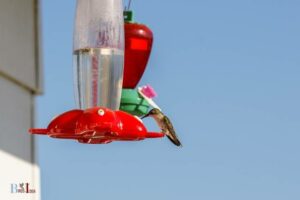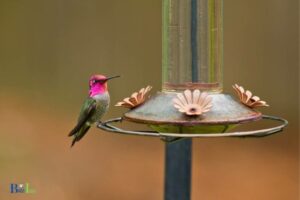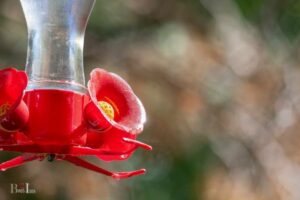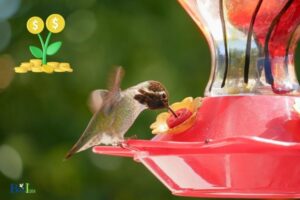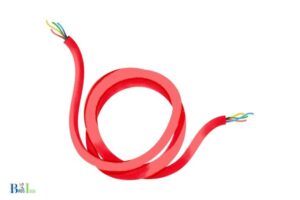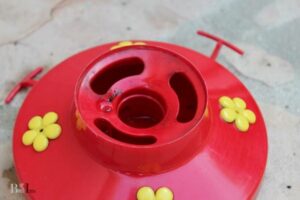How Many Hummingbirds Will Share A Feeder? 2-6!
It is common to see multiple hummingbirds sharing a feeder, with anywhere from 2-6 or even more hummingbirds feeding simultaneously.
However, the exact number of hummingbirds that will share a feeder depends on various factors, such as feeder size, availability of nectar, and territorial behavior among the birds.
By providing multiple feeders and ensuring an abundant nectar supply, you can encourage more hummingbirds to share feeders and minimize territorial behaviors.
5 Number of Hummingbirds Will Share A Feeder:
| Number of Hummingbirds | Feeder Sharing Behavior |
|---|---|
| 1 | Individual Use |
| 2-3 | Sharing Occasionally |
| 4-6 | Regular Sharing |
| 7-10 | Frequent Sharing |
| 11+ | Crowded |
Key Takeaway
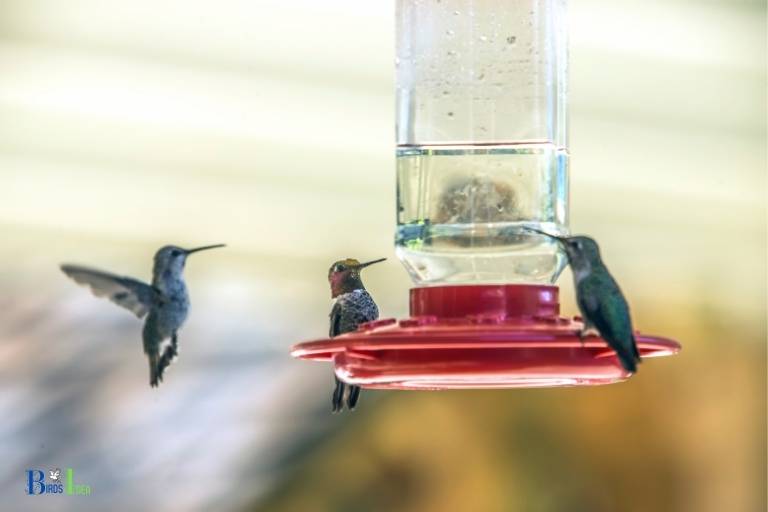
Five Facts About:
How Many Hummingbirds Can Fit on a Feeder?
It is not uncommon to see multiple hummingbirds sharing a feeder, however, the exact number that can fit on a feeder depends on the feeder’s design and the birds’ behavior.
Generally, hummingbird feeders have multiple feeding ports, ranging from 2 to 10 or more.
- Feeder design: The number of feeding ports and spacing between them will determine how many birds can fit comfortably.
- Hummingbird behavior: Some hummingbirds are territorial and may chase others away, limiting the number that will share a feeder at one time.
To attract more hummingbirds and reduce competition for space, consider using multiple feeders with different designs and varying numbers of ports.
Providing ample space for these tiny birds to feed and interact can help promote harmony in your backyard hummingbird sanctuary.
“Hummingbirds are fiercely territorial birds and will often fight over food sources, including feeders.”
– The Spruce
What Factors Impact the Number of Hummingbirds Sharing a Feeder?
The number of hummingbirds sharing a feeder can be influenced by various factors. These include feeder size and nectar quantity, feeder location, the presence of territorial species, and the time of year.
A larger feeder with more nectar will attract more hummingbirds, while a secluded feeder location may limit the number of birds visible.
Some territorial species may try to dominate a feeder, reducing the number of other birds visiting. Lastly, the number of hummingbirds may vary depending on migration patterns and seasonal availability of natural resources.
- Feeder size and nectar quantity
- Feeder location
- Territorial species
- Time of year (migration patterns, seasonal resources)
Pro Tip: To accommodate more hummingbirds, consider setting up multiple feeders in various locations around your property. This will minimize competition and encourage a greater number of birds to visit.
birdsidea
How to Attract More Hummingbirds to a Feeder?
Attracting more hummingbirds to a feeder can be achieved through several strategies. Hummingbirds are known for their love of sweet nectar, bright colors, and clean environments.
To attract a higher number of hummingbirds, consider using the following tips:
- Choose a brightly-colored feeder: Opt for red or orange feeders, as these colors are particularly attractive to hummingbirds.
- Provide fresh nectar: Change the nectar in your feeder every few days to keep it fresh and free from bacteria.
- Add multiple feeders: Some hummingbirds can be territorial, so having multiple feeders can encourage more birds to visit your yard.
- Offer different types of feeders: Experiment with different styles, like drip or dish feeders, to attract a variety of hummingbirds.
- Surround your feeders with flowering plants: Adding plants like hummingbird-friendly flowers can create a more appealing environment for them.
- Keep feeders clean: Regularly clean your feeders to prevent mold and bacteria from detering hummingbirds.
By applying these tips, you can successfully increase the number of hummingbirds visiting your feeders and enjoying your outdoor space.
How to Determine the Size of Feeder Needed for Multiple Hummingbirds?
Determining the appropriate size of a feeder for multiple hummingbirds involves considering factors such as the number of birds, their feeding habits, and your own preferences.
It is essential to accommodate the needs of these tiny creatures while maintaining a convenient and manageable feeder size.
- Observe the number of hummingbirds visiting your garden regularly.
- Choose a feeder with multiple feeding ports to avoid territorial disputes.
- A feeder with a 12-ounce capacity should suffice for a small group of hummingbirds.
- For larger groups or multiple species, consider a feeder with a capacity of 16 ounces or more.
- Monitor the feeder to ensure an adequate supply of nectar and avoid overcrowding.
In high-traffic areas, consider placing multiple smaller capacity feeders at different locations to distribute the feeding activity and reduce territorial disputes among the hummingbirds.
How to Create an Environment for Multiple Hummingbirds at a Feeder?
Creating an environment that can accommodate multiple hummingbirds at a feeder is essential to ensure all visitors have a chance to refuel.
It is important to remember that hummingbirds can be territorial and may not willingly share a feeder.
To encourage multiple hummingbirds to feed simultaneously, consider the following steps:
- Use multiple feeders: Place several feeders around your garden, ideally at least 6 feet apart. This will give each bird its own space and reduce territorial disputes.
- Opt for feeders with multiple ports: Look for feeders that have four or more feeding ports to allow more birds to feed together.
- Set up natural perches: Install nearby perching spots like a nearby branch, so the birds can rest and observe the feeder without feeling threatened.
- Keep feeders clean and filled: Ensure a constant supply of fresh nectar and clean the feeders regularly to prevent bacteria growth, making it safe for all visitors.
By following these tips, you’ll be able to create a welcoming environment for multiple hummingbirds to enjoy your feeder.
Tips for Maintaining a Feeder for Multiple Hummingbirds
Maintaining a feeder for multiple hummingbirds requires proper care and attention to ensure all birds have access to an adequate food source.
Many hummingbirds will share a feeder; however, they may be territorial. To manage this, ensure there are multiple feeders available around your yard.
Regular cleaning and refilling of feeders are essential to maintain hygiene and provide nutrition for the hummingbirds.
- Set up multiple feeders at different locations to avoid overcrowding
- Refill feeders with fresh nectar regularly, ideally every 2-3 days
- Clean feeders thoroughly once a week to prevent mold and bacteria growth
- Use a 4:1 water to sugar ratio for homemade nectar to mimic natural flower nectar
- Avoid using red dye in homemade nectar as it can be harmful to birds
Plant native flowers around your yard to provide additional natural nectar sources and attract various species of hummingbirds.
Conclusion
In conclusion, the number of hummingbirds that can share a feeder depends on various factors such as the size of the feeder, the number of feeding ports, and the territorial behavior of the hummingbirds.
To attract more hummingbirds to a feeder, it is essential to create a favorable environment and maintain a clean and hygienic feeder.
Determining the appropriate size of the feeder and providing enough space for multiple hummingbirds to feed can also increase their numbers.
By following these tips and providing an optimal environment for hummingbirds, you can enjoy watching these beautiful birds in your backyard.
On average, a single hummingbird feeder can accommodate up to four birds at a time. However, larger feeders or multiple feeders placed at different locations can attract and feed more hummingbirds simultaneously. According to the National Audubon Society, a well-maintained feeding station can support up to 20 hummingbirds at once.
birdsidea
FAQ On How Many Hummingbirds Will Share A Feeder
How many hummingbirds can feed from a single feeder?
Do hummingbirds prefer to feed alone or in groups?
How often should a hummingbird feeder be refilled?
What is the best type of feeder to attract hummingbirds?
How do you make a hummingbird feeder?
Hummingbirds are fascinating creatures that can be attracted to your garden by using a hummingbird feeder. Making a hummingbird feeder is a straightforward process and can be easily done at home with some simple materials.
Here are the steps to create a hummingbird feeder:
- Gather materials which consist of a plastic bottle, red spray paint, wire, pliers, and sugar water.
- Cut four small holes in the plastic bottle using a sharp object.
- Spray paint the plastic bottle with red color, which is preferred by hummingbirds.
- Cut a wire into a length of 12 inches using pliers and bend it in half.
- Thread each end of the wire through the holes in the plastic bottle and twist to hold it in place.
- Pour sugar water into the plastic bottle using a funnel and hang the feeder in your garden using the wire.
- Clean the feeder every three days to prevent mold buildup.
- Use a 1:4 sugar-water ratio for the nectar.
- Red dye is not necessary for hummingbirds and may be harmful; opt for red glass or a red ribbon to attract them instead.
Where is the best place to put a hummingbird feeder?
Knowing how many hummingbirds will share a feeder is one thing, but finding the ideal location to place your feeder is another.
Here are a few suggestions on where to put your hummingbird feeder for optimal birdwatching:
- Choose a spot that is easily visible, but away from high-traffic areas to avoid disturbing the birds from feeding.
- Place the feeder near flowering plants to attract even more hummingbirds to your yard.
- Hang the feeder in a shaded area to prevent the nectar from spoiling too quickly in the sun.
- Keep the feeder at least 3-4 feet away from windows to avoid causing injury to the birds in case of window strikes.
To prevent bees and wasps from invading the feeder, consider using a guard or placing the feeder near a bee and wasp repellent plant like mint or basil.
What is the difference between a male and female hummingbird?
Male and female hummingbirds look very similar at first glance, but upon closer observation, there are a few key differences to look out for.
Here are some distinguishing characteristics:
- Male hummingbirds usually have more vibrant and colorful feathers, while females tend to have more muted tones.
- Male hummingbirds also have more colorful markings on their throats, called gorgets, that they use to attract mates and deter other males.
- Female hummingbirds tend to be slightly larger in size than males.
- Juvenile hummingbirds of both sexes can be difficult to distinguish from one another, as they lack the distinctive markings and colors of adult birds.
Overall, while male and female hummingbirds may seem alike, there are subtle differences to look out for that can help you accurately identify their sex.
What time of day do hummingbirds feed the most?
Hummingbirds are known to be active during the day and are known to feed multiple times throughout the day.
However, there are specific times of day when they feed the most. Typically, hummingbirds feed more frequently in the early morning hours as there tends to be less wind, foliage is still moist from dew, and insects are more active.
They will also feed heavily in the late afternoon as it is cooler, and the sugar water in feeders is fresher. In general, hummingbirds feed the least during the midday hours when it is the hottest.
When it comes to hummingbirds sharing feeders, it depends on the size of the feeder and the number of feeding ports. Generally, a good rule of thumb is to provide one feeding port per hummingbird.
Which hummingbird feeder is best?
When it comes to attracting hummingbirds, choosing the right feeder can make all the difference.
Here are some of the best hummingbird feeders to consider:
- First Nature 3051 hummingbird feeder: This affordable option has a sizable capacity and is easy to clean.
- Perky-Pet 203CPBN hummingbird feeder: This feeder features an ant moat and four feeding ports, and is also dishwasher safe.
- Aspects 367 hummingbird feeder: With its durable polycarbonate construction and detachable perch, this feeder is built to last and offer a comfortable feeding experience for the birds.
No matter which feeder you choose, remember to keep it clean and filled with fresh nectar to attract and keep hummingbirds coming back to your yard.
What is the best food for hummingbirds?
Hummingbirds need a high sugar diet that simulates the nectar they extract from flowers. The best food for them is therefore a mixture of sweet water and sucrose (white table sugar).
Here are the steps to create the perfect hummingbird food:
- Boil one part sugar with four parts water to kill bacteria and dissolve sugar.
- Let the mixture cool to room temperature before filling your feeder.
- Store the remaining mixture in the fridge for up to a week.
- Do not add food coloring, honey, or artificial sweeteners as they can be harmful to hummingbirds.
Clean your feeder with hot water and soap every few days to prevent mold and bacteria buildup.

